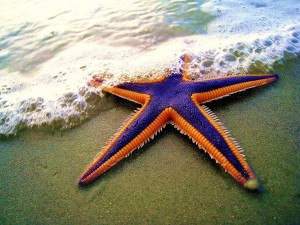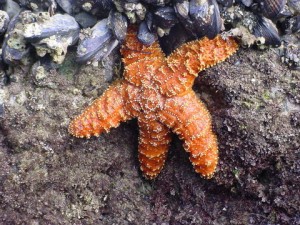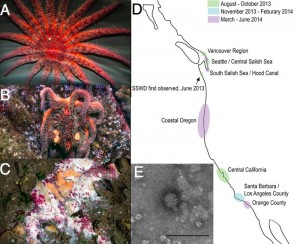Happy Fun Science FRIEDay!
While Ebola wreaks havoc on Homo sapiens in the terrestrial world, there has been an even more virulent disease causing the destruction of a marine animal, the sea star. Today we talk about this deadly condition impacting sea star populations and the recent discovery of just what is causing this affliction.

(Photo credit: TheMargue – http://www.fotopedia.com/items/flickr-2884079538)
Sea stars, also commonly known as starfish, are star-shaped echinoderms that typically have a central disc and five arms. Sea stars are generally considered to be keystone species in their respective habitats given their unique life history traits (size, diets, adaptability). In fact, Robert Paine first used the term “keystone species” in 1966 to describe the sea star, Pisaster ochraceus.

(Photo credit: Rosario Beach Marine Laboratory)
Last year, a mysterious disease began appearing in sea stars in the Pacific. From Alaska to Mexico, sea stars from 20 different species were contracting an unknown disease, and the death toll was in the millions. This mystery disease was extremely deadly, condemning nearly 100% of sea stars that contracted the disease to a horrific death. Known as sea star wasting disease, an infected sea star would undergo rapid degradation (fancy science speak for melting). In the end, all that would be left of the infected sea star would be a pile of slime and a few pieces of invertebrate skeleton.

(Photo Credit: Hewson et al., PNAS)
Despite the magnitude of the calamity scientist were perplexed at what was causing the disease, that is until a team of American and Canadian scientists, led by Ian Hewson of Cornell University, recently revealed the culprit to be a virus. Ian and his team were unsure if a bacteria, virus, or parasite caused sea star wasting disease, but after examining hundreds of slides of infected sea star tissue, they surmised the disease was likely caused by a virus. They then devised an experiment to affirm their suspicions. They injected healthy sea stars with the liquefied tissue of infected sea stars, and also injected a control group of sea stars with the same liquefied tissue, except they sterilized the tissue to kill any pathogens. Sure enough, a week after being injected with the non-sterilized tissue, healthy sea stars began exhibiting sea star wasting disease and eventually experienced mortality.
Going a step further to identify the virus, Ian and his team then genetically sequenced and sorted the infected sea stars’ tissue. Those analyses yielded a genome of a previously unknown virus, which the researchers named sea star-associated densovirus. This virus is similar to diseases known to infect insects and also has genetic similarities to a disease that occasionally infects Hawaiian sea urchins.
Now that the virus impacting these sea stars has been identified, questions still remain about the origin, and what is next for sea stars in the wild still battling this pathogen.
You can read more about this interesting study that Ian et al. published in the Proceedings of the National Academy of Sciences.